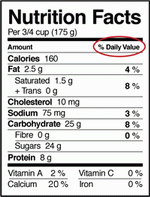FOOD LABELS
Food labels can help you eat well!
By Lynn Roblin MSc.RD.

Consumers today admit to being confused when it comes to making healthy food choices. Should we be looking for more fat-free foods? Does cholesterol-free mean low fat? What about trans fat? How can we tell if one cereal is a higher source of fibre than another?
Sorting out which foods are best suited to our needs isn’t always easy. But when it comes to actually buying foods, product labels are the number one source of nutrition information for Canadians. However, it’s important to understand the food label to get the nutritional goods you are looking for.
Many food labels make claims that can be confusing or misleading. For example, cholesterol-free doesn’t mean fat-free. Potato chips, for instance, can be labeled “cholesterol-free” but they provide plenty of fat. A small bag of potato chips (about 2 ½ cups or 56 g) provides about 20 grams of fat. Those chips would use up about one-third of a woman’s daily fat limit.
The point here is that you need to look at the fine print, not just the nutrition claim to make decisions about what you buy. Whenever a nutrition claim is made, for example, “high in fibre” or “fat-free”, a nutrition facts table will appear on the product label. The nutrition facts table is your guide to making healthy food choices.
The following guidelines will help you make sensible choices when shopping
Fat-free: Provides less than 0.5 g fat per serving
Fat-free does not mean calorie free. While fat-free products offer important fat saving, they won’t help you achieve a healthy weight if you eat limitless amounts. Calories still count and excess calories contribute to weight gain.
Low in fat: Provides no more than 3 g of fat per serving
Check the labels on your favorite foods or at your fast food stop. To be called low in fat, any food, including salad dressing, muffins, yogurt, etc., must contain no more than 3 grams of fat per serving. That means, a low fat muffin containing 2.6 grams of fat would qualify but one containing 6 grams of fat would not.
Low in cholesterol: Must have no more than 20 mg of cholesterol per serving and is also low in saturated fat.
Cholesterol-free: Must have no more than 2 mg of cholesterol per serving and is low in saturated fat.
People who are concerned with cutting back on dietary cholesterol should also check the amount of fat per serving on food labels. High intakes of fat , especially saturated and trans fat, contribute to high blood cholesterol levels. To keep in line with current nutrition recommendations women should limit their total daily fat intake to less than 65 grams and men to less than 90 grams.
Low in saturated fat: Must contain less than 2 grams of saturated fat and trans fat combined per serving.
Free of trans fat: Must contains less than 0.2 grams of trans fat per serving and be low in saturated fat.
Currently trans fat is receiving a lot of media attention and food companies are scrambling to reduce the amount of trans fat in their food products. Unfortunately not all food labels show the amount of trans fat as food companies have until December 2005 to put trans fat on their food labels. In the meantime to reduce trans fat in your diet, cut back on foods made with “hydrogenated” or “partially hydrogentated oils”, including many commercial baked goods, snack foods and deep fried foods.
High source of fibre: Look for at least 4 grams of dietary fibre per serving.
To even be considered a source of fibre, a food must contain at least 2 grams of fibre per serving. If you are looking for a high fibre food, choose one such as a breakfast cereal, that contains 4 or more grams of fibre per serving. Whole grain foods containing wheat bran and oat bran are usually high in fibre as are many vegetables and fruits. Adults should aim for 25 -35 grams of fibre per day.
What does the % Daily Value on the food label show?
The % Daily Value appears on the new food labels. It is a simple benchmark for evaluating the nutrient content of foods quickly and easily. The % Daily Value can be used to determine whether there is a lot or a little of a nutrient in a serving of the food. The Daily Values are based on recommendations for a healthy diet. You can us the % Daily Value to compare information on foods labels to find foods that are higher in calcium, iron or vitamin C.
Need more information? Visit Health Canada’s nutrition labelling website.
